Enhanced Thermoelectric Performance of Cu2SnSe3-Based Composites Incorporated with Nano-Fullerene
Abstract
:1. Introduction
2. Experimental Procedures
3. Results and Discussion
3.1. Microstructure and XRD Analysis
3.2. Electrical Transport Properties
3.3. Thermal Transport Properties
3.4. Figure of Merit
4. Conclusions
Acknowledgments
Author Contributions
Conflicts of Interest
References
- Disalvo, F.J. Thermoelectric cooling and power generation. Science 1999, 285, 703–706. [Google Scholar] [CrossRef] [PubMed]
- Yu, Y.; Lv, L.; Wang, X.Y.; Zhu, B.; Huang, Z.; Zu, F.Q. Influence of melt overheating treatment on solidification behavior of Bi2Te3-based alloys at different cooling rates. Mater. Des. 2015, 88, 743–750. [Google Scholar]
- Liu, W.S.; Yan, X.; Chen, G.; Ren, Z.F. Recent advances in thermoelectric nanocomposites. Nano Energy 2012, 1, 42–56. [Google Scholar] [CrossRef]
- Wan, S.; Huang, X.Y.; Qiu, P.F.; Bai, S.Q.; Chen, L.D. The effect of short carbon fibers on the thermoelectric and mechanical properties of p-type CeFe4Sb12 skutterudite composites. Mater. Des. 2015, 67, 379–384. [Google Scholar] [CrossRef]
- Zerer, W.G.; Lalonde, A.; Gibbs, Z.M.; Heinrich, C.P.; Panthofer, M.; Snyder, G.J.; Tremel, W. Influence of a nano phase segregation on the thermoelectric properties of the p-type doped stannite compound Cu2+xZn1-xGeSe4. J. Am. Chem. Soc. 2012, 134, 7147–7154. [Google Scholar] [CrossRef] [PubMed]
- Raju, C.; Falmbigl, M.; Rogl, P.; Heinrich, P.; Royanian, E.; Bauer, E.; Mallik, R.C. Thermoelectric properties of Zn doped Cu2SnSe3. Mater. Chem. Phys. 2014, 147, 1022–1028. [Google Scholar] [CrossRef]
- Liu, G.H.; Li, J.T.; Chen, K.X.; Li, Y.; Zhou, M.; Han, Y.M.; Li, L.F. Direct fabrication of highly-dense Cu2ZnSnSe4 bulk materials by combustion synthesis for enhanced thermoelectric properties. Mater. Des. 2016, 93, 238–246. [Google Scholar] [CrossRef]
- Shi, X.Y.; Xi, L.L.; Fan, J.; Zhang, W.Q.; Chen, L.D. Cu-Se bond network and thermoelectric compounds with complex diamondlike structure. Chem. Mater. 2010, 22, 6029–6031. [Google Scholar] [CrossRef]
- Fan, J.; Liu, H.L.; Shi, X.Y.; Bai, S.Q.; Shi, X.; Chen, L.D. Investigation of thermoelectric properties of Cu2GaxSn1-xSe3 diamond-like compounds by hot pressing and spark plasma sintering. Acta Mater. 2013, 61, 4297–4304. [Google Scholar] [CrossRef]
- Skoug, E.J.; Cain, J.D.; Morelli, D.T. Thermoelectric properties of the Cu2SnSe3-Cu2GeSe3 solid solution. J. Alloy. Compd. 2012, 506, 18–23. [Google Scholar] [CrossRef]
- Lan, Y.C.; Minnich, A.J.; Chen, G.; Ren, Z.F. Enhancement of thermoelectric figure of merit by a bulk nanostructuring approach. Adv. Funct. Mater. 2010, 20, 357–376. [Google Scholar] [CrossRef]
- Zolriasatein, A.; Yan, X.; Bauer, E.; Rogl, P. Influence of PCA on thermoelectric properties and hardness of nanostructured Ba-Cu-Si clatherates. Mater. Des. 2015, 87, 883–890. [Google Scholar]
- Zebarjadi, M.; Esfarjani, K.; Ren, Z.F.; Chen, G. Perspectives on thermoelectric: From fundamentals to device applications. Energy Environ. Sci. 2012, 5, 5147–5162. [Google Scholar] [CrossRef]
- Kim, K.T.; Choi, S.Y.; Shin, E.H.; Moon, K.S.; Ha, G.H. The influence of CNTs on the thermoelectric properties of a CNT/Bi2Te3 composite. Carbon 2013, 52, 541–549. [Google Scholar] [CrossRef]
- Blank, V.D.; Buga, S.G.; Kulbachinskii, V.A.; Kytin, V.G.; Stepanov, P.B. Thermoelectric properties of Bi0.5Sb1.5Te3/C60 nanocomposites. Phys. Rev. 2012, 86, 64–70. [Google Scholar] [CrossRef]
- Kulbachinskii, V.A.; Kytin, V.G.; Popov, M.Yu.; Buga, S.G.; Blank, V.D. Composites of Bi2-xSbxTe3 nanocrystals and fullerene molecules. J. Solid State Chem. 2012, 193, 64–70. [Google Scholar] [CrossRef]
- Shi, X.; Chen, L.; Yang, J.; Meisner, G.P. Enhanced thermoelectric figure of merit of CoSb3 via large-defect scattering. Appl. Phys. Lett. 2004, 84, 2301–2303. [Google Scholar] [CrossRef]
- Itoh, T.; Ishikawa, K. Effects of fullerene addition on thermoelectric properties of n-type skutterudite compound. J. Mater. Res. 2007, 22, 249–255. [Google Scholar] [CrossRef]
- Nandihlli, N.; Lahwal, A.; Holgate, T.C.; Tritt, T.M. Thermoelectric properties of composites made of Ni0.05Mo3Sb5.4Te1.6 and fullerene. J. Solid State Chem. 2013, 203, 25–30. [Google Scholar] [CrossRef]
- Faleev, S.V.; Leonard, F. Theory of enhancement of thermoelectric properties of materials with nanoinclusions. Phys. Rev. 2008, 77, 214304. [Google Scholar] [CrossRef]
- Zebarjadi, M.; Esfarjani, K.; Shakouri, A.; Zeng, G.; Lu, H.; Zide, J.; Gossard, A. Effect of nanoparticle scattering on thermoelectric power factor. Appl. Phys. Lett. 2009, 94, 202105. [Google Scholar] [CrossRef]
- Orton, J.W.; Powell, M.J. The Hall effect in polycrystalline and powdered semiconductors. Rep. Prog. Phys. 1980, 43, 1263–1307. [Google Scholar] [CrossRef]
- Zhao, D.G.; Zuo, M.; Geng, H.R. Synthesis and thermoelectric properties of CoSb3/WO3 thermoelectric composites. Intermetallics 2013, 40, 71–75. [Google Scholar] [CrossRef]
- Xiong, Z.; Chen, X.H.; Huang, X.Y.; Bai, S.Q.; Chen, L.D. High thermoelectric performance of Yb0.26Co4Sb12/yGaSb nanocomposites originating from scattering electrons of low energy. Acta Mater. 2010, 58, 3995–4002. [Google Scholar] [CrossRef]
- Xi, L.L.; Yang, J.; Lu, C.F.; Chen, L.; Zhang, W.Q. Systematic study of the multiple-element filling in caged skutterudite CoSb3. Chem. Mater. 2010, 22, 2384–2394. [Google Scholar] [CrossRef]
- Shi, X.; Yang, J.; Salvador, J.R.; James, R. Multiple-filled skutterudites: High thermoelectric figure of merit through separately optimizing electrical and thermal transports. J. Am. Chem. Soc. 2011, 133, 7837–7846. [Google Scholar] [CrossRef] [PubMed]
- Morelli, D.T.; Jovovic, V.; Heremans, J.P. Intrinsically minimal thermal conductivity in cubic I-V-VI2 semiconductors. Phys. Rev. Lett. 2008, 101, 035901. [Google Scholar] [CrossRef] [PubMed]
- Cho, J.Y.; Shi, X.; Salvador, J.R.; Meisner, G.P. Thermoelectric properties and investigations of low thermal conductivity in Ga-doped Cu2GeSe3. Phys. Rev. 2011, 84, 085207. [Google Scholar] [CrossRef]
- Liu, F.S.; Wang, B.; Ao, W.Q.; Li, Y.; Li, J.Q. Crystal structure and thermoelectric properties of Cu2Cd1-xZnxSe4 solid solutions. Intermetallics 2014, 55, 15–21. [Google Scholar] [CrossRef]
- Do, D.T.; Mahanti, S.D. Theoretical study of defects Cu3SbSe4: Search for optimum dopants for enhancing thermoelectric properties. J. Alloy. Compd. 2015, 625, 346–354. [Google Scholar] [CrossRef]
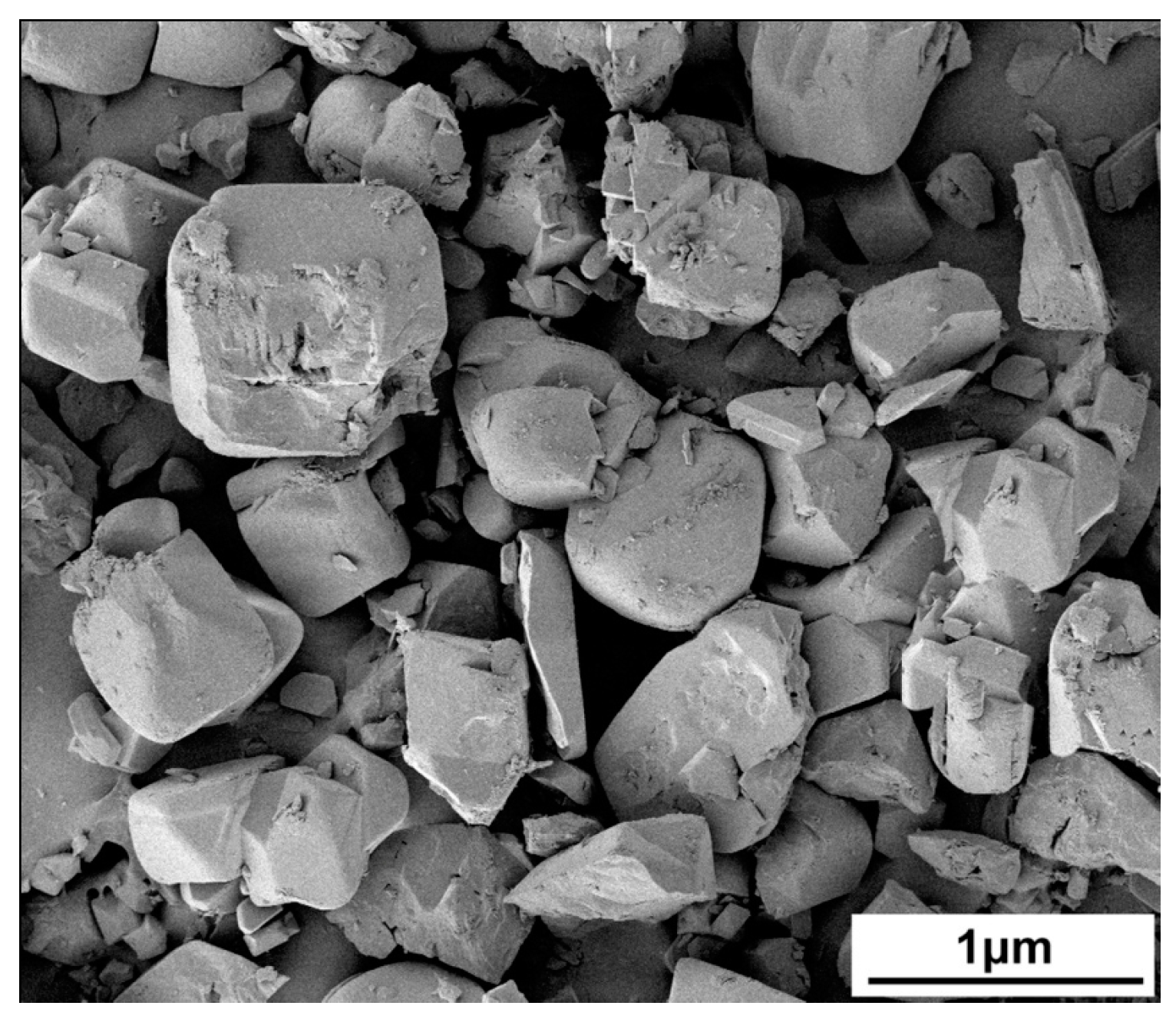

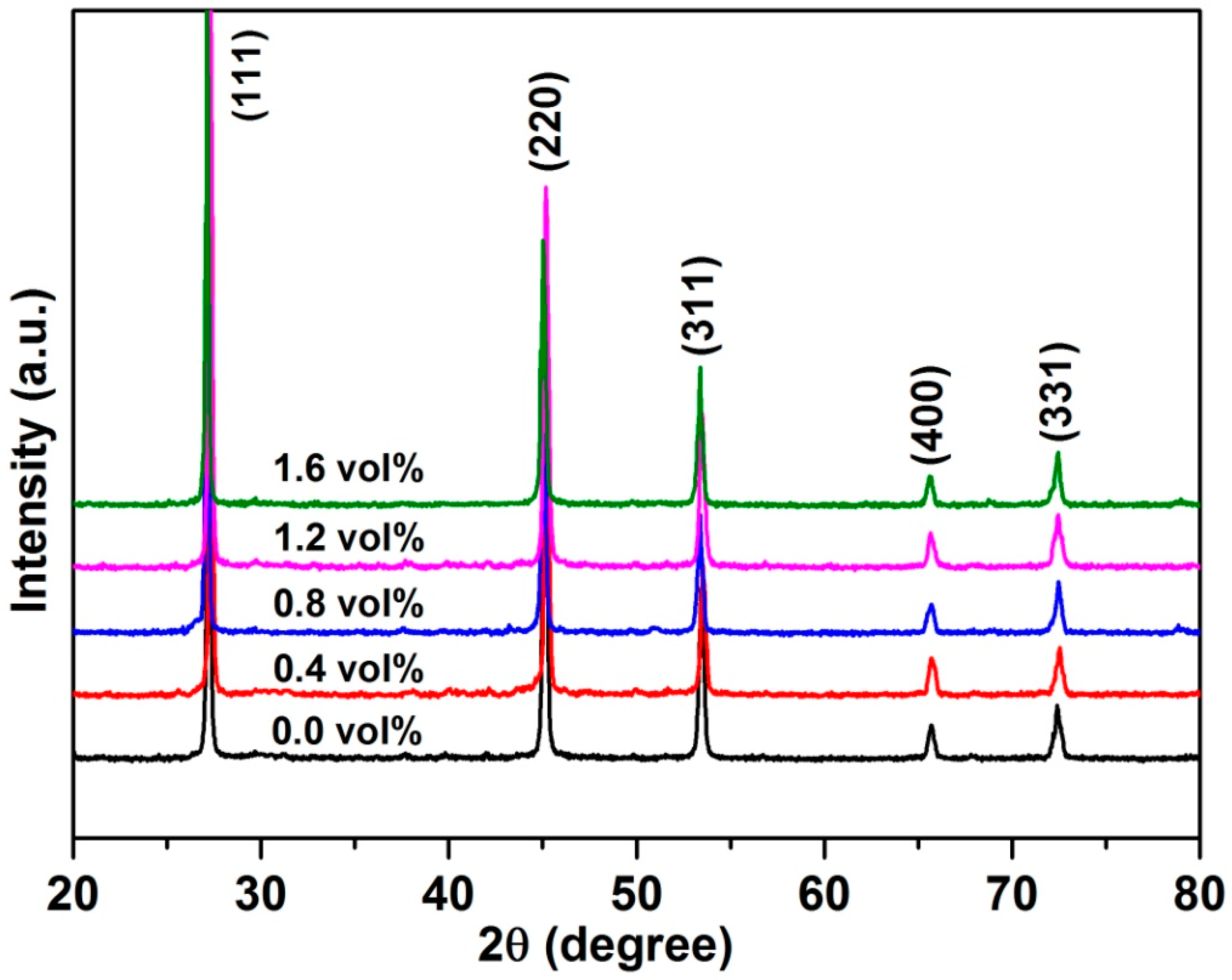
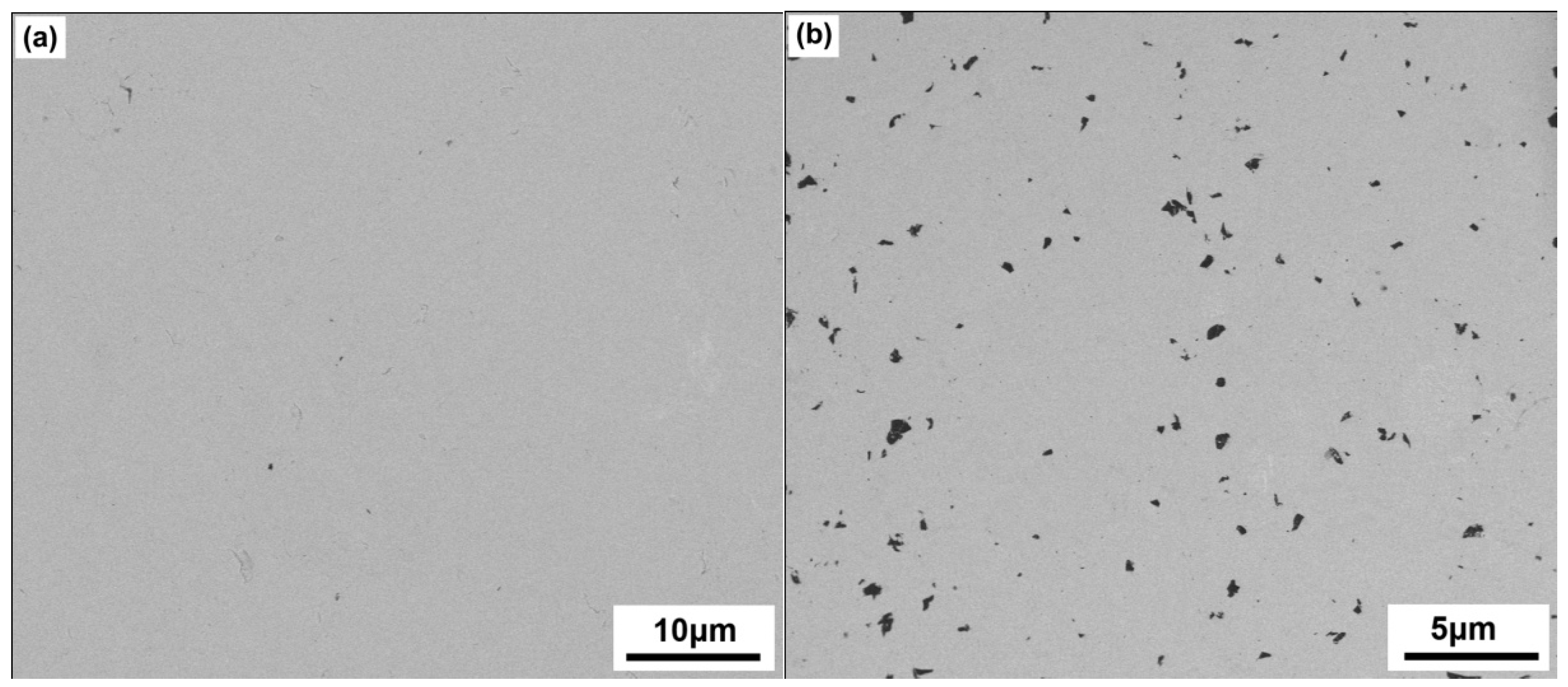

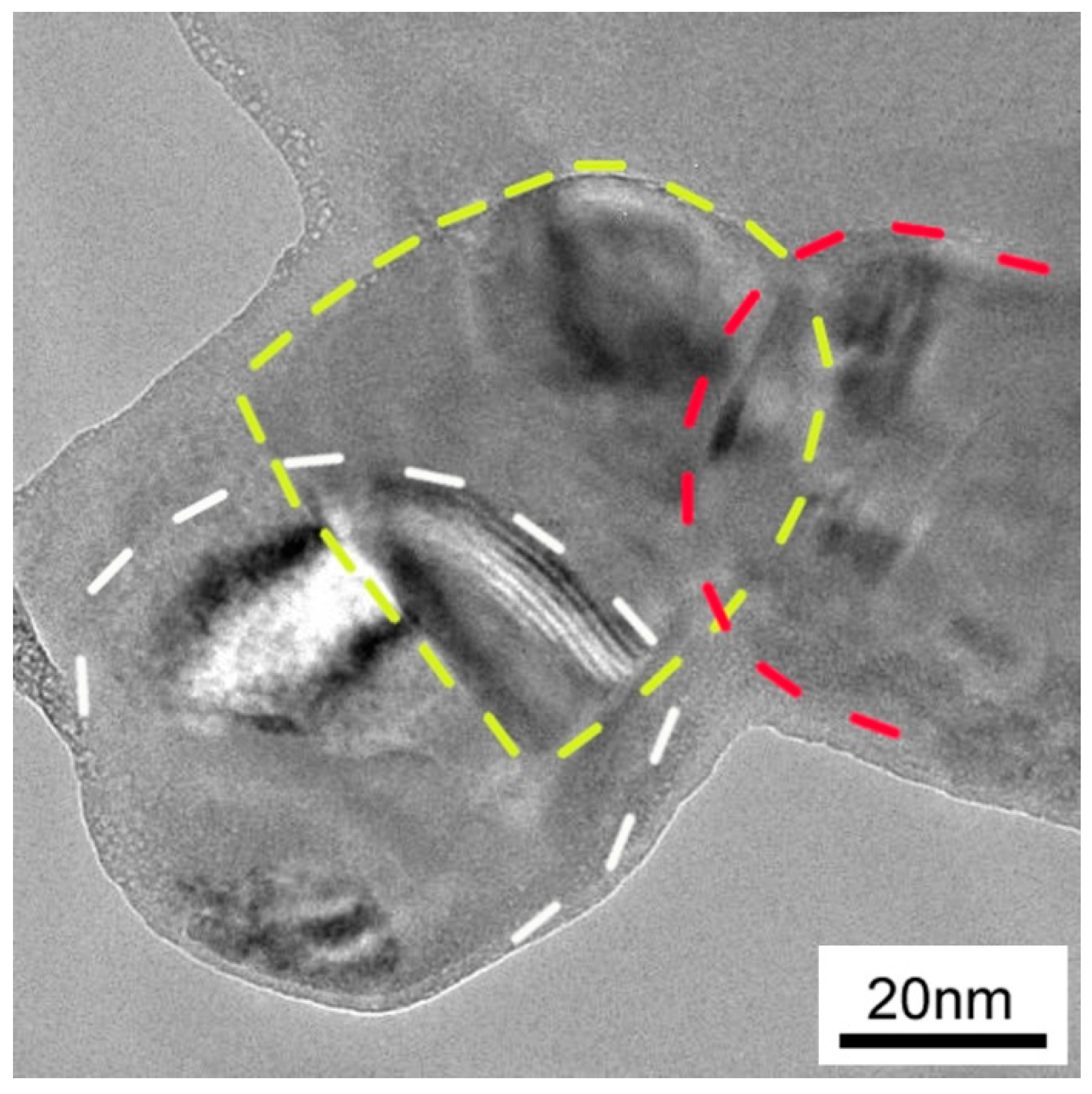
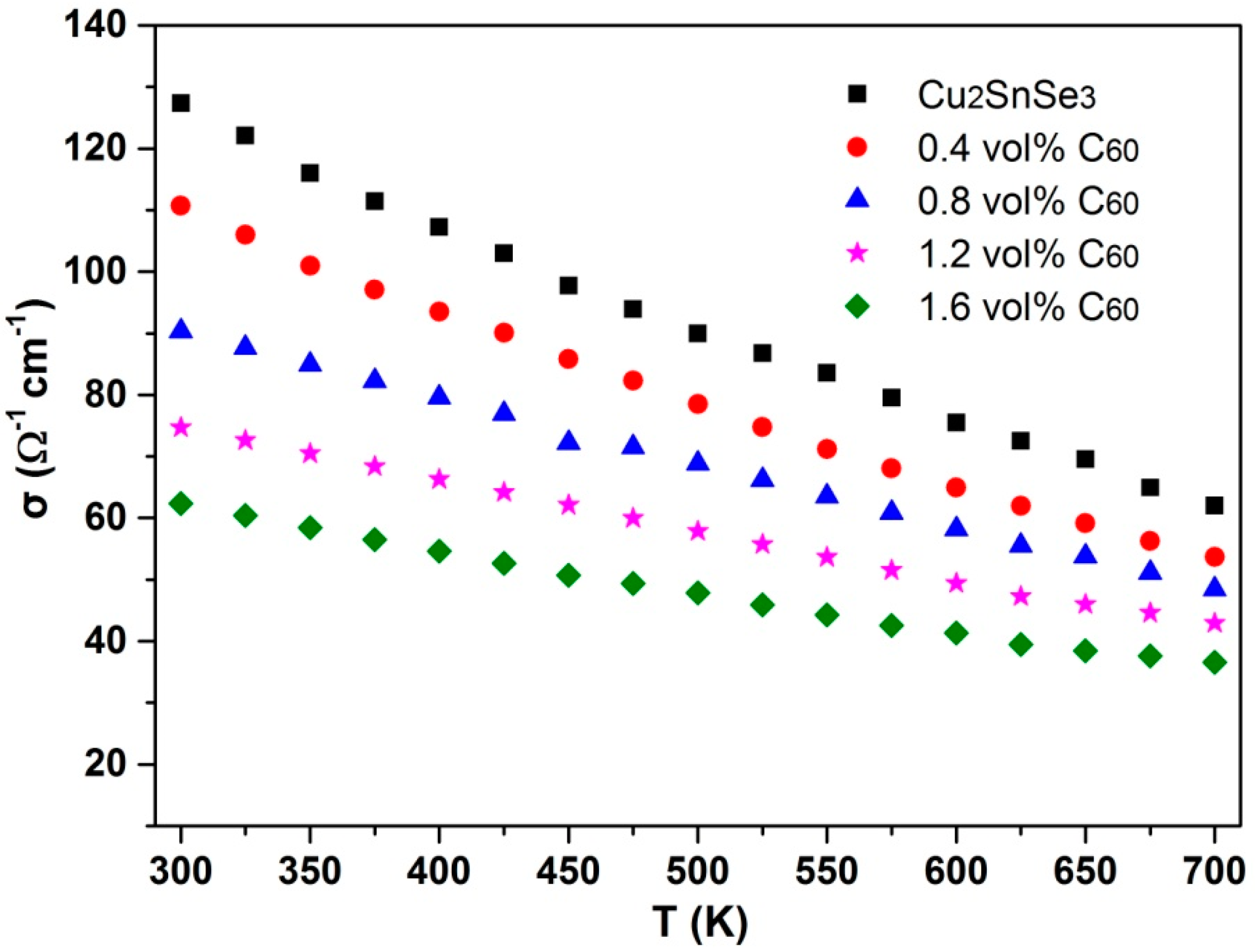
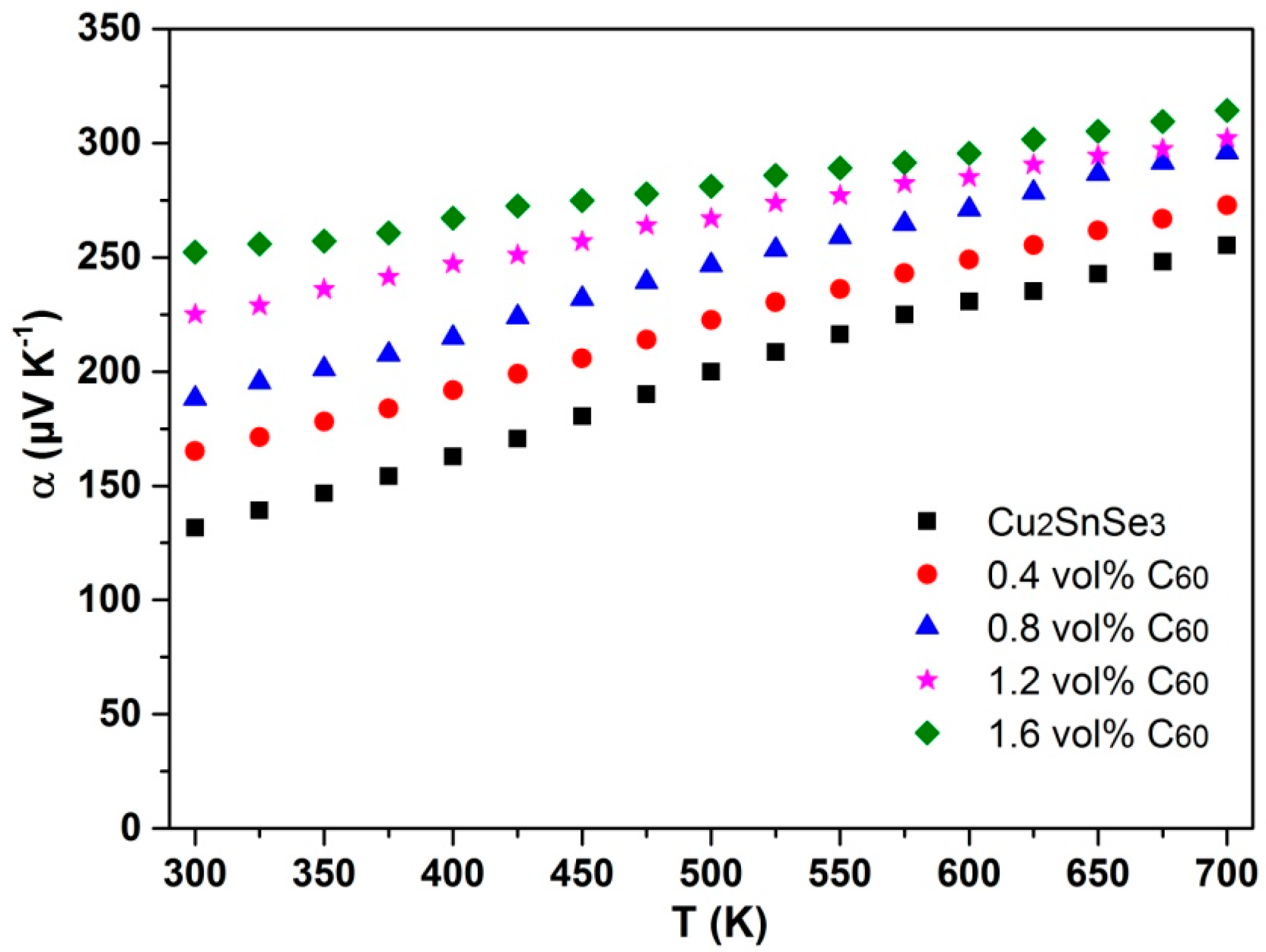
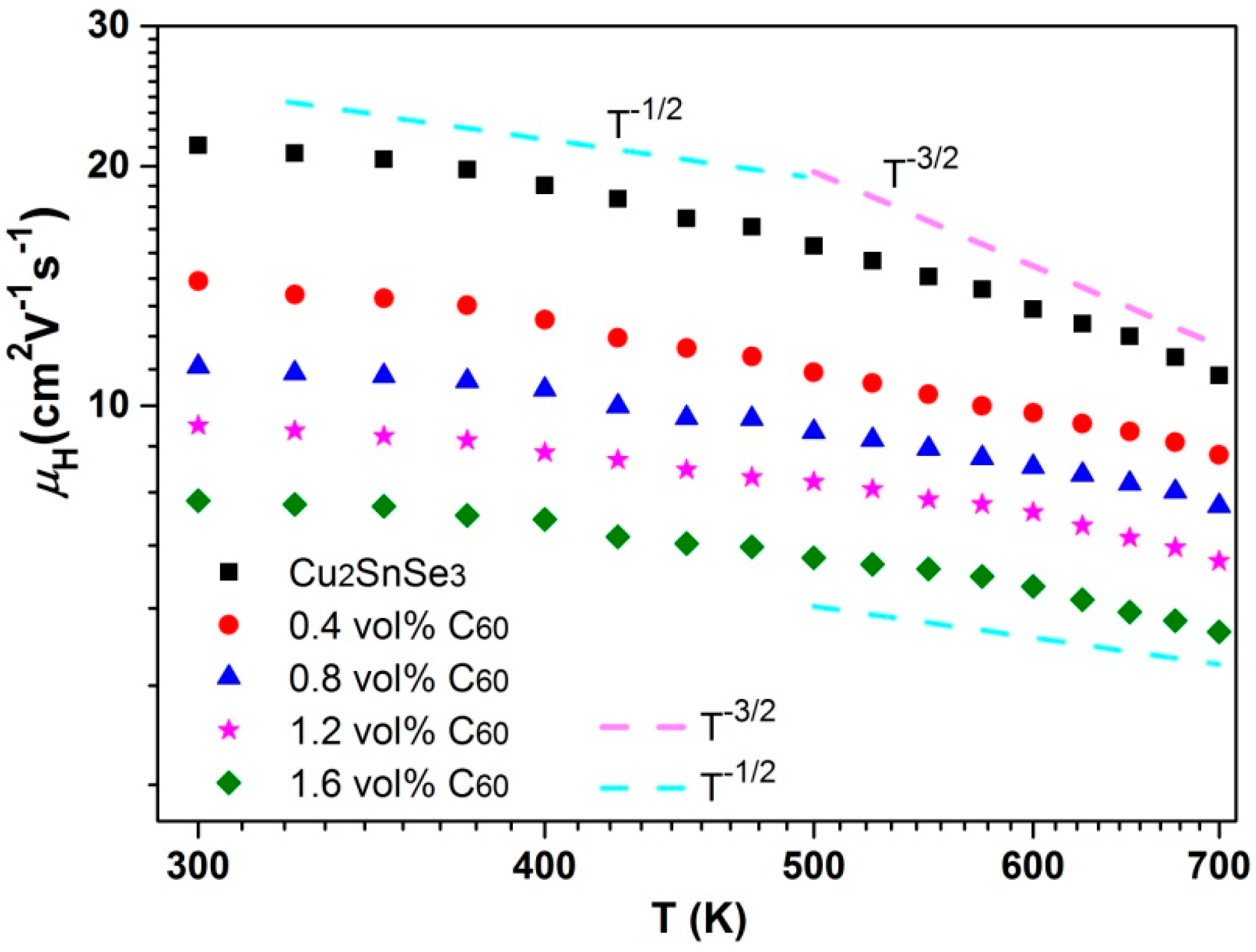
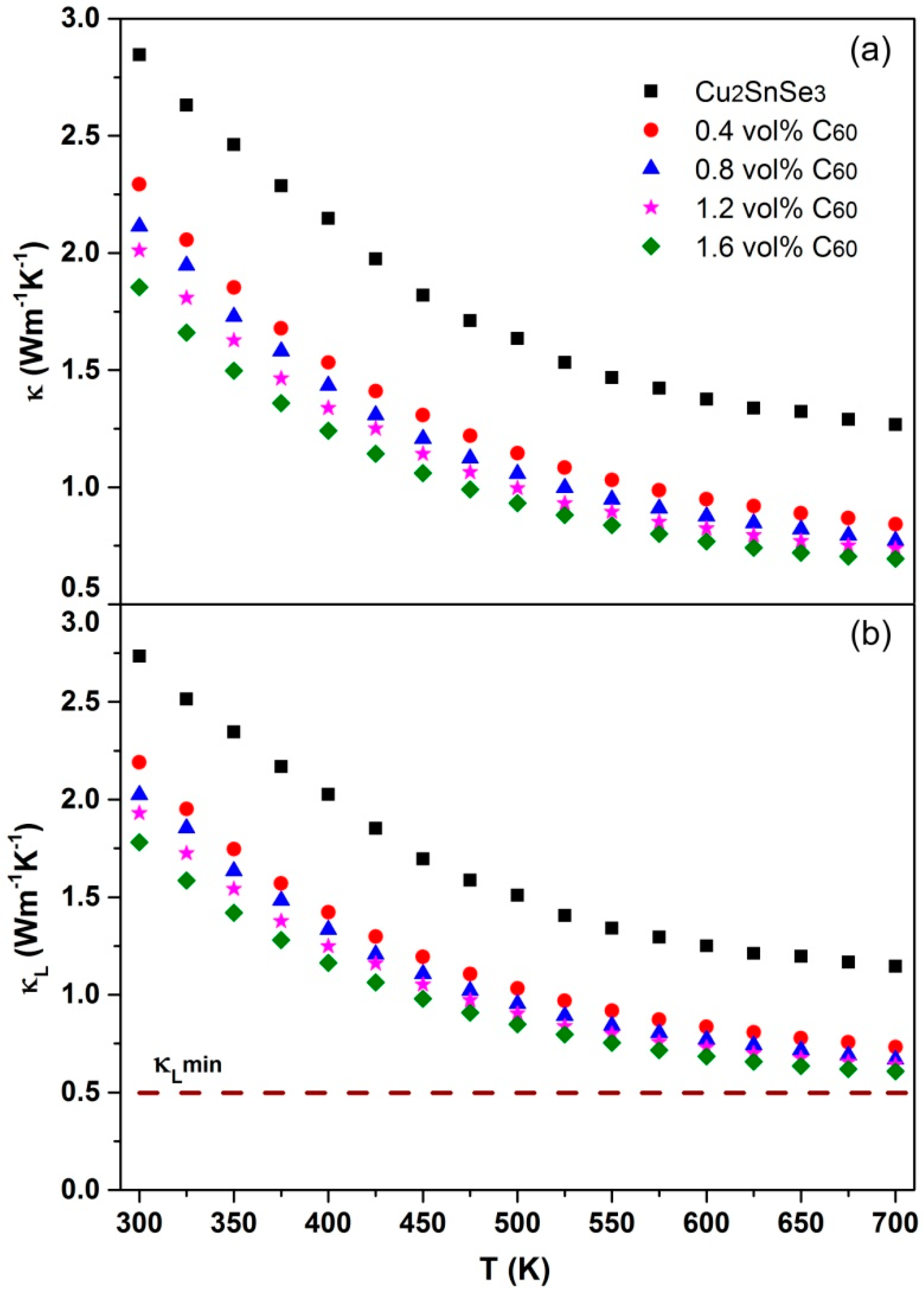
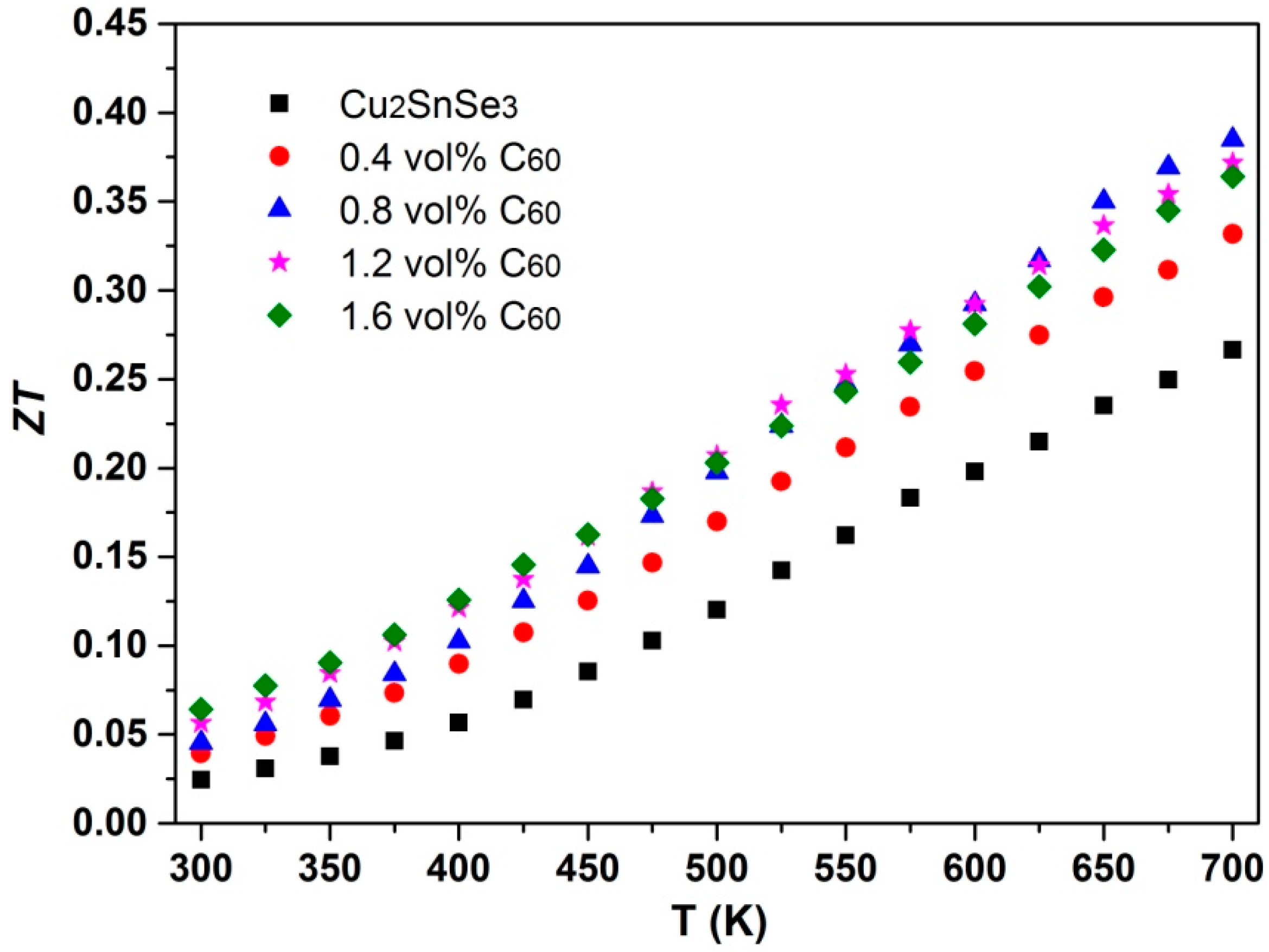
| x (vol %) | Relative Density | σ (Ω−1·cm−1) | p (1019cm−3) | μH (cm2/Vs) | α (μV/K) | κL (Wm−1·K−1) | m* (m0) |
|---|---|---|---|---|---|---|---|
| 0 | 98.7% | 127 | 3.74 | 21.2 | 131 | 2.77 | 2.6 |
| 0.4 | 97.2% | 110 | 4.81 | 14.3 | 165 | 2.22 | 2.8 |
| 0.8 | 98.9% | 90 | 5.01 | 11.2 | 188 | 2.06 | 2.9 |
| 1.2 | 98.2% | 75 | 4.98 | 9.4 | 225 | 1.96 | 3.1 |
| 1.6 | 97.9% | 62 | 5.09 | 7.6 | 252 | 1.81 | 3.2 |
© 2016 by the authors; licensee MDPI, Basel, Switzerland. This article is an open access article distributed under the terms and conditions of the Creative Commons Attribution (CC-BY) license (http://creativecommons.org/licenses/by/4.0/).
Share and Cite
Zhao, D.; Ning, J.; Wu, D.; Zuo, M. Enhanced Thermoelectric Performance of Cu2SnSe3-Based Composites Incorporated with Nano-Fullerene. Materials 2016, 9, 629. https://doi.org/10.3390/ma9080629
Zhao D, Ning J, Wu D, Zuo M. Enhanced Thermoelectric Performance of Cu2SnSe3-Based Composites Incorporated with Nano-Fullerene. Materials. 2016; 9(8):629. https://doi.org/10.3390/ma9080629
Chicago/Turabian StyleZhao, Degang, Jiai Ning, Di Wu, and Min Zuo. 2016. "Enhanced Thermoelectric Performance of Cu2SnSe3-Based Composites Incorporated with Nano-Fullerene" Materials 9, no. 8: 629. https://doi.org/10.3390/ma9080629
APA StyleZhao, D., Ning, J., Wu, D., & Zuo, M. (2016). Enhanced Thermoelectric Performance of Cu2SnSe3-Based Composites Incorporated with Nano-Fullerene. Materials, 9(8), 629. https://doi.org/10.3390/ma9080629






